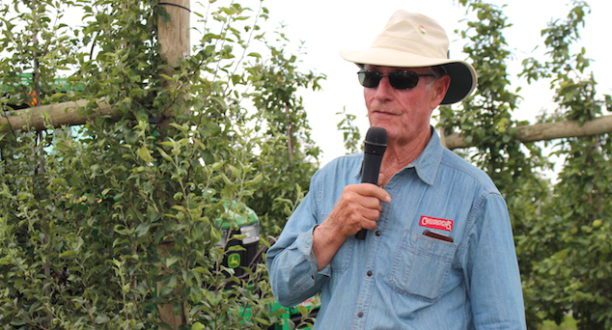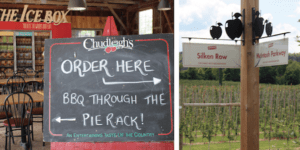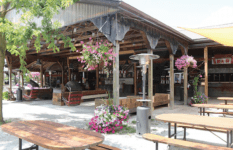

Jan 22, 2020Chudleigh’s Farm remains an Ontario staple
Tom Chudleigh’s philosophy regarding orchard production after 50 years in the business can be summed up in one simple credo: “Pay attention to the revenue; get all you can out of every apple you grow because it’s going to cost you the same no matter what.”
“If you look at your costs over the last five years they probably haven’t changed,” Chudleigh said. “Oh yea, they probably went up a little bit here and there, but you cut costs there and here. So the cost is not much different. (As an example) you’ve had your first big pick of Honeycrisp, and so your revenue went up, and you probably had a very good year.”
Chudleigh shared his perspective to conclude the International Fruit Tree Association’s (IFTA) summer 2019 visit to his wide-ranging operation in Milton, Ontario, Canada.
Eric Chudleigh, Tom’s father, purchased the 100-acre farm 67 years ago, and grew his own apple trees on M.9, planting the first 12-acre orchard in 1956-1957.
The development of the pick-your-own method of marketing/selling began 53 years ago in 1967, with entertainment features beginning seven years later. The employee numbers grew over each year from four staffers in the winter season to 110 at harvest time.
Now, the farm includes a retail store, outdoor restaurant, pick-your own orchards, an adult-sized playground, petting zoo and a considerable amount of customer-friendly real estate. Farm operators want the place to feel like “Grandpa’s backyard” with recreational activities for all ages.
Specialty apples a hit
The farm, located within an easy drive from Toronto, is situated on silk loam over clay and gravel at an elevation of 550 feet. Of the 55 acres in orchard production, 37 are irrigated. Grown are 28 varieties of apples. Rootstocks used for plantings have varied over the years, Chudleigh said.
“For 25 years, we favored the M.9 type at 800 to 1,000 trees per acre,” he said. “For the last four years, we have preferred c.935 at 1,100 trees an acre. The farm mulches one-third of the acreage every year.”
Kerr Mini, Sunrise, Silken, Tolman Sweet, Tydeman Red, Wealthy and Creston are among the unique apple varieties available on the farm.


Chudleigh talked about a 2018 planting of Creston, “a great retail apple,” that is a Honeycrisp look-alike. It was planted 30 inches apart on 13.5-foot spacings.
“Honeycrisp, once they start getting to crop, they don’t seem to want to grow anymore,” he said. “These (Creston) don’t do that. There is less bitter pit. They are quite a good apple. They have this one silly, little habit that’s obnoxious at times and that is they like to die in the wintertime. So we usually have a 100 trees that we’re replacing here and have for the last three or four years. But the variety is so well accepted that we’re going to go on with it.”
Chudleigh’s son Dean, orchard managers Bruce Shannon and Riley Bruce also welcomed the IFTA visitors to their pick-your-own operation. Shannon, who is retiring, has been with Chudleigh’s for 46 years.
Shannon described how after seeing “double-buttered” trees on a trip to Michigan, he returned to Chudleigh’s farm, knowing he probably could not secure those type of trees.
“So, we planted young trees, grew two leaders on them and they kept pace.”
He described a 2017 bi-axle leader planting of Red Ambrosia that was a little slow coming into bearing like they prefer.
“The size of the tree matters,” Shannon said. “These trees were too big of a diameter when we planted them and didn’t have that young wood-initiated push when we made this cut.”
Popular pastry picks
Chudleigh’s popular Apple Blossom – a single-serving apple pie dessert – is served in restaurants and sold in grocery stores globally, even shipping as far away as Australia and Dubai.
The Blossoms and Chudleigh’s other baked products are manufactured at a massive 110,000-square-foot bakery with over 100 full-time employees just down the road from the farm in Milton. It has made the business a direct-sale force in the industry.
During peak times of August through October, the farm attracts in the neighborhood of 8,000 visitors a day.


“Remember this is entertainment,” Chudleigh told the visitors from IFTA, of which he is a past president. “Even though we’re dispatching apples, we’re entertaining people. It’s a big difference from a standard farm.”
“Our spacings are probably a little wider than you’re used to in a slender spindle system,” Chudleigh said. “But when we have as many people picking as we do, we can’t see any grass down the rows. It’s solid people for three rows.”
“We have so many people some days that people are packed in too tight and they don’t like it. They can’t get past each other,” Chudleigh said. “We’ll get our efficiency out of price-per-pound,” after customers easily navigate the farm.
To get into the orchard during harvest, customers pay a $15 entry fee for the farm experience that includes a wagon ride, petting farm, play structures with adult-sized slides, and lots of room to play. Apples are purchased by the bag, small or large – no scales are used.
“We’re in the golf club (type) business in that we want a real nice, thick and heavy orchard grass in the rows for customers,” Chudleigh said.
“If you have a nice 3- to 3.5-inch apple on that tree and they’ve got their child there to show them what an apple looks like on a tree, you couldn’t find a picker who would pick your fruit more carefully than they will,” he said. “Customers are very, very careful with the trees.”
The farm plans to continue future plantings of 13.5 to 14 feet wide, 30 inches between trees.
Those new plantings will continue to feature of Fuji, Gala, Ambrosia and Honeycrisp.
Chudleigh is a big fan of Sunrise. Originating from the Summerland Research Station in British Columbia in the 1990s, the apple variety works well at pick-your-own farms.
“Sunrise variety is worth looking into. It’s an end-of-August apple that’s crispy, juicy and it brings customers in at that time window just for this apple,” he said. “When it’s ripe it does look like a sunrise if you can imagine reds, oranges and yellows blending together – it’s a beautiful-looking apple and, against green foliage, people can’t resist picking them.”
Keeping it rolling
Hitting all their marks during a busy harvest season is one of the challenges of operating such a substantial pick-your-own business.
“We do gamble quite a bit on the harvest time, and have for years, and we want the apples dead-right sweet without any starchiness at all,” Chudleigh said. “It is risky leaving them on as long as we do. We have been bitten before when a weather pattern comes through that limits the crowd. But when you watch somebody bite into a fully ripe McIntosh apple, you’ll know immediately if we succeeded.”
Chudleigh’s goal is to have ripe apples every day for at least two months.
“We like lots of trees that appreciate for 25 years,” he said.
“These trees produce large apples, better color, and higher volume this close. We want a 3.5-inch apple. We want a wow factor,” he says. “We want them dead ripe; we don’t want them starchy.”
Platforms are used to pick the tops of trees and workers usually pick the centers of the trees, too. Apples are sold to wholesale and in their farm market.
The operation charges $20 for a 10-lb. bag and Honeycrisp have sold for as low as $2 a pound, Chudleigh said.
— Gary Pullano, managing editor














